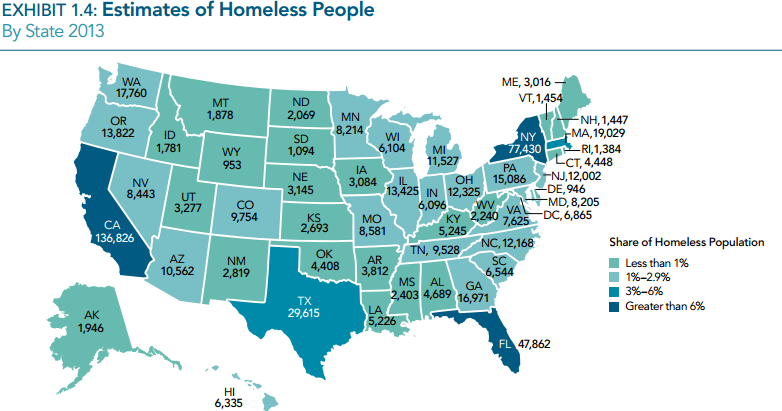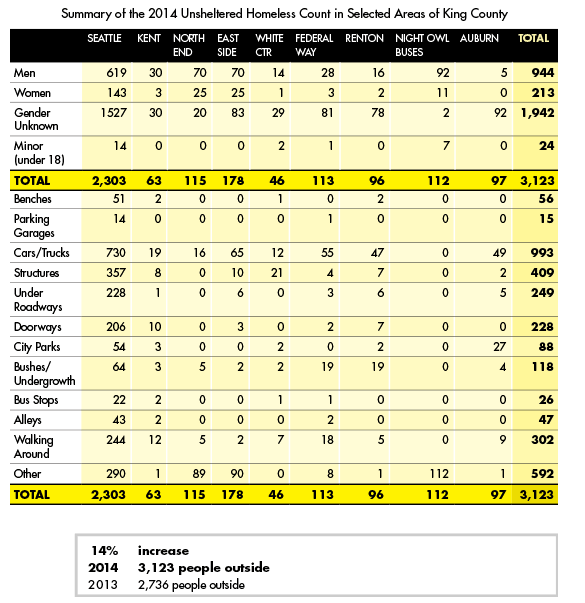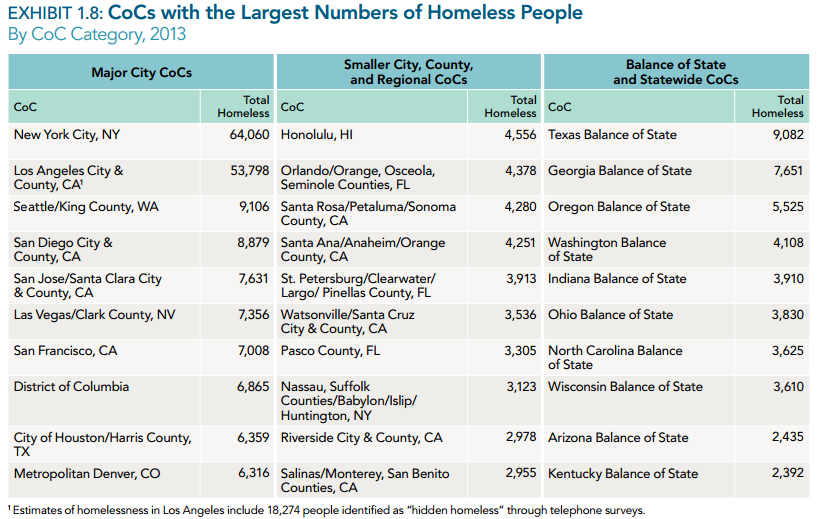(There’s a lot of data in the 2013 HUD report on homelessness. This is part 1 of The Urbanist’s series to better understand this data. You can see Part 2 here.)

The Department of Housing and Urban Development (HUD) does a yearly analysis of homelessness in the US and released their research for 2013 in August. This report is largely based on a single night count of homelessness among participating Continuum of Care (CoC) organizations, local planning organizations that manage all aspects of homelessness from providing shelter to providing permanent housing. The federal government provides most of the funding for homeless services in the country and ties the use of that money to guidelines regarding those services. Among these guidelines are requirements regarding the structure and responsibilities of local organizations that want to be eligible for funds and these organizations are referred to as CoCs. In Seattle, there is a coordination of resources and organizations, referred to as the Seattle/King County CoC. (I will be publishing a series of posts about the data found in this report, focusing on the Seattle/King County CoC.)
To get a handle on the makeup and number of people experiencing homelessness, HUD attempts to collect accurate information on the entire homeless population without counting anyone twice. Data collection mostly depends on a ‘single night count.’ Organizations responsible for solving homelessness conduct a count of the population within their jurisdiction on a single night each year. The count usually takes place at the end of January, and the results from Seattle were widely published this year. This method isn’t perfect—it relies heavily on volunteers and possibly misses variations in homelessness during the year—but it is the best data available for understanding homelessness in the United States.

Important Findings
The scale and details of the homeless problem in the US can be very discouraging, but there are also reasons for hope. Some of the particularly stark findings from this year’s report include:
- There are 610,042 homeless people in the US.
- Nearly 35% were unsheltered. Unsheltered areas are defined as a location not ordinarily used for sleeping and can include ‘temporary shelters’ such as a car or abandoned building, but also areas such as tent cities.
- 23% of all homeless people were under the age of 18.
While Seattle saw an increase in homelessness between 2013 and 2014, the region was growing. Additionally, there is good news on the federal level regarding homelessness:
- Chronic homelessness of individuals decreased 7% since 2012 and 25% since 2007.
- Homelessness among veterans declined 24% between 2009 and 2013.
- Since 2007 there has been a 23% decline in unsheltered homelessness.
- Those in shelters has increased 1% since 2007.
- Homelessness overall declined 9% since 2007.
- 61,846 fewer people are homeless since 2007.
Federal Homelessness Goals
The federal government has four primary goals regarding homelessness:
- End chronic homelessness by 2015, defined as continuous homelessness for at least one year or four episodes of homelessness in the last three years.
- End homelessness for veterans by 2015.
- End homelessness for youth and families by 2020.
- Make progress towards ending all homeless.
It’s not clear to me whether the federal goals are on track to be successful. The report notes that the progress towards ending homelessness of youth and families has seen small declines, suggesting that the goal is not on track. Additionally, the report’s stated goal of providing a “path” toward ending homelessness is not clear enough to understand what progress towards that goal might look like beyond a declining rate of homelessness.
Seattle and Washington
Some of the notable data from 2013 in Washington State includes:
- 17,760 homeless people in 2013.
- 4th largest decline in homelessness between 2007 and 2013, 5,619 (24%).
- 3rd largest absolute decline in homeless families between 2012 and 2013: -2,088 (-22.6%); and the 4th largest between 2007 and 2013: -2,947 (-29.2%).
- 2,196 chronically homeless people.
- 1,136 unaccompanied homeless children and youth.
All the data for Seattle is a combination of Seattle and King County since there is a coordinated effort in this region. Some of the notable data in 2013 from the Seattle/King County CoC includes:
- 3rd most homeless people (9,106) among participating CoCs.
- 6th most homeless people in families (3,120) among participating CoCs.
- 7th largest number (5,986) of homeless individuals among participating CoCs.
- 7th largest number (533) of unaccompanied, homeless children and youth among participating CoCs.
- 9th largest number (682) of homeless veterans among participating CoCs.

In future posts, I’ll expand further on the data for the Seattle/King County CoC since the national report does not discuss these numbers in detail.

Owen Pickford
Owen is a solutions engineer for a software company. He has an amateur interest in urban policy, focusing on housing. His primary mode is a bicycle but isn't ashamed of riding down the hill and taking the bus back up. Feel free to tweet at him: @pickovven.


